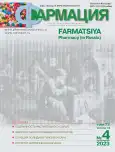Development of anti-adhesion membrane technology for isolation of intestinal anastomosis
- Authors: Strusovskaya O.G.1, Rytchenkov S.V.1
-
Affiliations:
- Volgograd State Medical University
- Issue: Vol 72, No 4 (2023)
- Pages: 45-49
- Section: Technology of medicines
- URL: https://bakhtiniada.ru/0367-3014/article/view/142784
- DOI: https://doi.org/10.29296/25419218-2023-04-06
- ID: 142784
Cite item
Abstract
Introduction. According to statistics, the incidence of complications after operations on the abdominal organs in the form of peritoneal adhesions is 63–97%. Most often, PS are formed after surgical interventions on the intestine, resulting in the development of intestinal obstruction. This complication can lead to dehydration, electrolyte imbalance, necrosis, abdominal abscess, kidney failure, intestinal perforation, and sepsis. Currently, the lack of effective anti-adhesion barriers determines the relevance of the development of new domestic remedies for the prevention of the development of postoperative adhesions, especially during surgical interventions on the intestines.
Purpose of the study. Development of a technology for obtaining a biodegradable anti-adhesion membrane.
Material and methods. To obtain a biodegradable antiadhesion membrane, a mixture of biopolymer solutions of chitosan and gelatin in various ratios was used as film formers. Anti-adhesion membranes were obtained by Young's method. Biodegradation was studied in rat blood plasma and sodium phosphate buffer solution.
Results. In the course of the studies, it was found that the temperature and humidity at which drying is performed do not have a significant effect on the qualitative characteristics of the membranes, and the main factors that determine their structural and mechanical properties are the composition and thickness of the layer of the mixture of film formers. Thus, membranes based on film-forming solutions of gelatin and chitosan in ratios of 2.5:1.5 provide a tensile strength of 86.4 MPa, an elongation at break of 6.7%, a thickness of 34 μm, which is considered satisfactory indicators of the structural and mechanical properties of biodegradable antiadhesion agents. membranes.
Conclusion. A technology for obtaining a biodegradable anti-adhesion membrane based on biopolymers has been developed. In rat blood plasma, membrane degradation occurred much faster than in sodium phosphate buffer solution, which indicates enzymatic degradation of membranes.
Keywords
Full Text
##article.viewOnOriginalSite##About the authors
Olga Gennadievna Strusovskaya
Volgograd State Medical University
Author for correspondence.
Email: strol3@yandex.ru
ORCID iD: 0000-0002-1771-7046
Doctor of pharmacy, associate professor, head department of pharmaceutical technology and biotechnology
Russian Federation, Pavshikh Bortsov Sq., 1, Volgograd, 400131Sergey Vitalievich Rytchenkov
Volgograd State Medical University
Email: rytchenkovs@gmail.com
ORCID iD: 0009-0005-7597-4138
Assistant of the department of pharmaceutical technology and biotechnology
Russian Federation, Pavshikh Bortsov Sq., 1, Volgograd, 400131References
- Magomedov M.M., Imanaliev M.R., Magomedov M.A. Postoperative abdominal adhesions: pathophysiology and prevention (literature review). Modern Science: Actual Problems of Theory and Practice. Series: Natural and Technical Sciences. 2020; 8–2: 73–80 (in Russian).
- Tang J., Xiang Z., Bernards M.T. et al. Peritoneal adhesions: occurrence, prevention and experimental models. Acta biomaterialia. 2020; 116: 84–104.
- Almabaev Y.A. et al. Antiadhesion drugs. Bulletin of the Kazakh National Medical University. 2017; 4: 283–5 (in Russian).
- Dubrovina S.O. Prevention of peritoneal adhesions in operative gynecology. Gynecology. 2012; 14; 6: 46–50 (in Russian).
- Mazitova M.I. The place of anti-adhesion barriers in operative gynecology. Kazan medical J. 2007; 88 (2): 184–6 (in Russian).
- Huang J.C., Yeh C.C., Hsieh C.H. Laparoscopic management for Seprafilm-induced sterile peritonitis with paralytic ileus: report of 2 cases. J. of Minimally Invasive Gynecology. 2012; 19; 5: 663–66.
- Strik C., Wever K., Stommel M., et al. Adhesion reformation and the limited translational value of experiments with adhesion barriers: A systematic review and meta-analysis of animal models. Scientific reports. 2019; 9: 1–10.
- Abdulgadiev V.S., Magomedov M.A., Damadaev D.M. Intraoperative prevention of adhesions in the abdominal cavity. Modern problems of science and education. 2017; 3: 72 (in Russian).
- Bakibaev A.A. et al. Anti-adhesion action of composite film materials based on carboxymethylcellulose sodium salt modified with glycoluril. Modern technologies in medicine. 2021; 13 (1): 35–41 (in Russian).
- Rivero S., Garcia M.A., Pinotti A. Composite and bi-layer films based on gelatin and chitosan. J. of food engineering. 2009; 90 (4): 531–9.
- De Masi A. et al. Chitosan films for regenerative medicine: Fabrication methods and mechanical characterization of nanostructured chitosan films. Biophysical Reviews. 2019; 11: 807–15.
- Konovalova M.V., Kurek D.V., Durnev E.A. and others. in vitro pectin-chitosan cryogels. Proceedings of the Ufa Scientific Center of the Russian Academy of Sciences. 2016; 3 (1): 42–5 (in Russian).
- Shahram E., Sadraie S.H., Kaka G. et al. Evaluation of chitosan–gelatin films for use as postoperative adhesion barrier in rat cecum model. International J. of Surgery. 2013; 11 (10): 1097–102.
- Khan M.Y. et al. A review-ceftriaxone for life. Asian Pharma Press. 2017; 7 (1): 35–48.
- Block D.R., Algeciras-Schimnich A. Body fluid analysis: clinical utility and applicability of published studies to guide interpretation of today’s laboratory testing in serous fluids. Critical reviews in clinical laboratory sciences. 2013; 50 (4–5): 107–24.
Supplementary files








